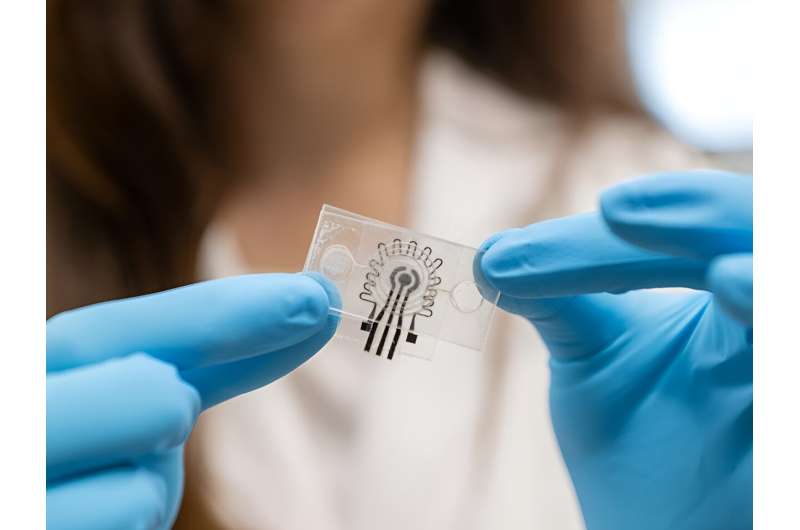This article has been reviewed according to Science X's editorial process and policies. Editors have highlighted the following attributes while ensuring the content's credibility:
fact-checked
peer-reviewed publication
trusted source
proofread
New wearable sensor makes continuous analysis of sweat possible, researchers say

Continuous monitoring of sweat can reveal valuable information about human health, such as the body's glucose levels. However, wearable sensors previously developed for this purpose have been lacking, unable to withstand the rigors or achieve the specificity needed for continuous monitoring, according to Penn State researchers. Now, the research team has created a novel wearable patch that may be up to the task.
Made with a laser-modified graphene nanocomposite material, the device can detect specific glucose levels in sweat for three weeks while simultaneously monitoring body temperature and pH levels, the researchers reported in Advanced Functional Materials.
"Sweat is ideal for real-time, continuous and noninvasive biomarker detection," said principal investigator Huanyu "Larry" Cheng, the James L. Henderson, Jr. Memorial Associate Professor of Engineering Science and Mechanics (ESM) at Penn State.
"But low biomarker concentration levels in sweat and variability of other factors such as pH, salinity and temperature have pushed previous sweat biosensors past the limits of their detection and accuracy. This device is able to account for this variability while measuring glucose with needed specificity for weeks at a time."
Cheng and his colleagues recognized from their previous sensor studies and work conducted by other researchers that laser-induced graphene (LIG) electrodes—electrodes fabricated with a nanomaterial constructed in a single step with laser scribing—could offer a promising starting point to develop a more effective wearable sweat sensor.
Despite limitations due to low sensitivity to glucose and a limited surface area for the necessary electrochemistry, Cheng said, LIG electrodes are simple to fabricate, affordable and flexible.
Working at the nanoscale, the researchers reported using a simple laser treatment to create a stable, 3D network of highly conductive noble metal alloys—gold and silver in this case—and carbon-based nanocomposite materials on the porous LIG electrode. Noble metals are not only highly conductive but are also resistant to oxidation, Cheng said.
By heating the gold and silver alloy nanocomposite material with a simple laser treatment, Cheng said the material also resists agglomeration. This is a common phenomenon where nanoparticles coalesce into clusters, limiting the material's surface area.
"Glucose on the surface of the modified LIG electrode oxidizes at lower potential," said first author Farnaz Lorestani, ESM postdoctoral scholar. "This oxidation generates a measurable current or potential change that is directly proportional to the overall glucose concentration in the solution. We also see far greater stability over time, with the laser-treated sensor losing only 9% of its sensitivity over three weeks compared to 20% sensitivity loss for a sensor without laser treatment."
In addition to measuring glucose, the modified LIG electrode responded to changes in pH levels, too, according to the researchers. To fabricate the wearable device, they combined the dual glucose and pH sensor with another LIG-based temperature sensor and a stretchable layer with coil-shaped microfluidic channels to continuously collect and route sweat for sampling.
The device allows for the calibration of glucose measurements based on fluctuations in sweat pH and body temperature from activities such as exercise and eating, Cheng said. Worn as a patch roughly twice the width of a postage stamp and affixed to the skin with adhesive tape, it can wirelessly communicate its collected data to a computer or mobile device for real-time monitoring and analysis.
"The result of our work is a sensor with the notable sensitivity and stability to monitor glucose levels over multiple weeks," Cheng said. "It is a low-cost platform offering convenient, accurate and continual analysis of sweat in diverse conditions, which has great potential for individual and population health, personalized medicine and precision nutrition."
More information: Farnaz Lorestani et al, A Highly Sensitive and Long‐Term Stable Wearable Patch for Continuous Analysis of Biomarkers in Sweat, Advanced Functional Materials (2023). DOI: 10.1002/adfm.202306117




















